Stagwell brought the Future of News to Cannes Lions, where our recent study showing that it’s safe for brands to advertise in the news was “the talk of the town,” according to Andrew Ross Sorkin in The New York Times’ DealBook and on CNBC’s “Squawk Box.” In the June edition of Hitting the Mark, I’m bringing you the Cannes highlights of all things Future of News, including insights from my interview with Business Insider; a Future of News panel featuring the CEOs of The New York Times, CNN, and Business Insider; and a Business of News panel featuring the CROs of top publishers.
As a recap, Stagwell’s landmark 50,000-person News Advertising Study, released in May, found that 1 in 4 Americans are news junkies — an audience whom advertisers are not capitalizing on. We showed that brand safety concerns — the idea that brands will suffer if their ads appear next to the “wrong” story — were unfounded: Americans don’t judge brands based on what news stories their ads appear next to.
I brought our findings to CMOs of the world’s biggest brands and news executives at Cannes this month. Four overarching themes emerged across our discussions:
- News junkies are an under-tapped, highly desirable, and wide-ranging audience. As I told Business Insider, if you’re not advertising in news, you’re probably not targeting your optimal consumers, so you’re probably not maximizing the benefit you can get out of your budget. News junkies are curious and persuadable individuals who come to the news with wide interests, ranging from cooking and games to fashion and sports.
- The vicious cycle of brands abandoning news is harming democracy. At the end of the day, news runs on business models. But because of brand safety apprehension, brands don’t advertise on news, news revenue declines, news quality worsens, and democracy suffers. Instead, advertisers need to start a “virtuous cycle” of investing in the news, as I wrote about in The Current. In the Sport Beach Content Studio, Dow Jones CRO Josh Stinchcomb talked about concrete ways to feed this virtuous cycle, such as convincing brands to move away from extensive, outdated blocklists.
- The news business has to be global. On the Sport Beach mainstage panel about Future of News, the CEOs of top publishers discussed the strength of having a global audience and why they are investing in their international coverage as a competitive advantage. In the same vein, we are planning to bring our Future of News research and studies around the world, with London up next.
- Integrating AI into journalism can help both news and brands target audiences even more effectively. Just like everyone else, newsrooms are tackling AI, and publisher CEOs spoke at Sport Beach about the ways they are implementing it: from an AI-enabled paywall at Business Insider to an AI-powered ad product designed to target consumers beyond first-party data at The New York Times. Stagwell agencies are already at the forefront of helping newsrooms with this AI reinvention. Code and Theory, which was just named ANA’s B2B Agency of the Year, is building expertise in this area with major projects such as designing and engineering NBC’s “Big Board” — a reliable, data-driven storytelling device depicting the nation’s political landscape in real time.

Coming out of Cannes, the future of news is clear: advertisers have a unique opportunity to target a curious, cream-of-the-crop audience, and AI will only augment reach.
The responsibility to invest in democracy is urgent: free, independent journalism is under ongoing attack. Just this week, The Wall Street Journal reporter Evan Gershkovich appeared in court for the start of an illegitimate and secret trial after 15 months of wrongful detention in Moscow. Share this letter from the Journal’s editor in chief to help elevate Evan’s story until he can tell his own.
We would love to have you on board our follow-up studies and summits as Future of News expands across the globe. Reach out to partner with the Stagwell team, and as always, please don’t hesitate to connect with any thoughts or questions.
Until next time,
Mark Penn
Related
Articles
In the News, Press Releases
Jul 09, 2025
STAGWELL LAUNCHES STAGWELL MEDIA PLATFORM (SMP), A CENTRALIZED TEAM OF GLOBAL MEDIA, TECHNOLOGY AND DATA INVESTMENT EXPERTS

In the News, Investments & Financials, Press Releases
Jul 08, 2025
Stagwell (STGW) Schedules Webcast to Discuss Financial Results for the Three Months Ended June 30, 2025

In the News, Investments & Financials, Press Releases, Talent & Awards
Jul 08, 2025
Stagwell (STGW) Advances Executive Team with Four Key Appointments

Newsletter
Sign Up
As the year comes to an end, it’s time for business leaders to take stock and realize the recession many of us feared this year did not hit. In fact, with consumers still spending healthily and sitting on lots of disposable income, now marks a bigger marketing opportunity than ever. In the December 2023 edition of Hitting the Mark – originally published in Barron’s – I share what leaders need to learn from the recession that never came.
As always, if you have questions or comments, please reach out to me.
Companies Cut Marketing as If a Recession Was Coming. It Didn’t.
Fears of a recession drove too many companies’ executive decisions this year. They hunkered down and cut marketing spending and maybe digital innovation, too. Then the news came that there was no recession—in fact consumers were spending on all sorts of consumables. Companies that bet on recession lost out.
The old, trusted brands faced little competition, since their nemeses pulled back. Consumers turned to familiar faces, and so the big companies pocketed market-share gains. Those chief financial officer-driven orders looked good on paper—in reality they cost businesses tremendously. Consumer timing outside of a recession is as impossible as stock market timing. Consumers often defy logic and expectations – and this year they were spending.
Pulling back wasn’t entirely irrational. This time last year just about everyone was scared of a looming recession. Reuters polled economists in Oct. 2022 and found 65% thought a recession would occur within the next year. In Dec. 2022, 80% of Americans thought the country was either already in a recession or would be in the following year, according to the Harvard CAPS/Harris poll.
But the recession never came. After steady growth all year the economy grew by 4.9% in the third quarter of 2023, driven primarily by consumers. Consumer spending increased 4% for the quarter and was responsible for 2.7 percentage points of the total GDP increase—signs of a strong economy.
Consumers Keep Spending…and Spending
Consumers turned out to have more money to spend than ever. Thanks to Covid-era stimulus bills and shutdowns, median net worth rose 37% from 2019 to 2022. Americans still have an estimated extra $1.7 trillion in savings. Even in the third quarter of 2023, disposable net income grew 3.8%, nearly triple what economists were forecasting. With the economy mostly returning to a post-pandemic normal, consumers are eager to spend on experiences.
Consumers went on a shopping spree this summer. Spending at movie theaters, restaurants, sporting events, and casinos all rose in August. Spending on international travel and airline transportation shot up in September. Overall last quarter, the consumer spending increase was spread almost evenly across goods and services.
It’s not just wealthy consumers who are opening their wallets. Retail sales have risen six months in a row. The holiday season is already off to a good start. Online spending for Black Friday was up 7.5% this year, according to Adobe. That’s right in line with a forecast of 7-9% for e-commerce holiday sales growth this year. Overall holiday season sales are estimated to rise 3-4%, less than the pandemic years, but that’s still a healthy increase.
The Challenger Imperative
So challenger companies that pulled back on spending wasted a whole year not getting their name out there and putting up a fight for new customers. Smaller brands suffer disproportionately when everyone cuts their marketing budgets. People will fall back on what they know rather than try new, unfamiliar things.
Companies need to recognize their mistake of pulling back in fear of the recession that wasn’t. The lesson for 2024 is to resist that fear again and think twice about cutting back on marketing and other engines of growth. Consumers are still sitting on lots of disposable income and the percentage of Americans who think the country will avoid a recession entirely has nearly doubled in the past twelve months. The Fed is holding rates steady and is hopefully done with its policy of economic blood-letting.
The established companies want the upstarts to keep doing nothing and giving away market share for free, but challengers must keep their foot on the gas pedal. They have even more ground to make up after this lost year. The recession never came, but the consequences were real and serious. Hopefully those trying to predict consumer trends will learn the lesson that many stock-market timers have learned—you pull back from advancing in the marketplace at your own peril.
Until next time,
Mark Penn
Related
Articles
In the News, Press Releases
Jul 09, 2025
STAGWELL LAUNCHES STAGWELL MEDIA PLATFORM (SMP), A CENTRALIZED TEAM OF GLOBAL MEDIA, TECHNOLOGY AND DATA INVESTMENT EXPERTS

In the News, Investments & Financials, Press Releases
Jul 08, 2025
Stagwell (STGW) Schedules Webcast to Discuss Financial Results for the Three Months Ended June 30, 2025

In the News, Investments & Financials, Press Releases, Talent & Awards
Jul 08, 2025
Stagwell (STGW) Advances Executive Team with Four Key Appointments

Newsletter
Sign Up
At the end of October, I brought my bestselling “Microtrends” franchise to the Association of National Advertisers’ annual Masters of Marketing conference keynote stage, and now I’m bringing the insights to you. This month’s edition of Hitting the Mark dives into these small, counterintuitive trends that have big impacts on society and will shape tomorrow’s consumers. If you want to predict the future, you must have a better understanding of the present.
Today’s consumers are older, more health-driven, more diverse and more divided into microtrends than ever before. Our world today is driven by personalization and technology. The march in personalization has transformed our economy from the Ford economy (any choice as long as it’s black) to the Starbucks economy (150 choices starting with black coffee) to the Uber economy (infinite personalized choices). But the paradox of choice is that more choices available lead to fewer choices made.
Here are the key microtrends that businesses should consider.
Life is an accordion. And it’s getting longer as life milestones are getting pushed back for the young and the old.
- Footloose and fancy-free: Since 1980, the median age of first marriage has increased eight years for women and men to 29 and 31, respectively.
- Mid-life fertility: Birth rates are jumping for women in their late 30s and early 40s with the median age of women giving birth rising to 30, the highest on record.
- Nonagenarians: The 90+ population has nearly quadrupled in the past 40 years to over 2.5 million Americans.
- Senior spenders: Last year the 65+ population accounted for a record 22% of U.S. spending with healthier finances, less need to borrow, and little worry about layoffs. And Baby Boomers are retiring with $77 trillion in wealth.
Tech goes both ways. Many Americans eagerly seek out the latest upgrades, but other groups are starting to intentionally opt out.
- Self-data lovers: 43% of Americans now track their health and fitness information, mainly on smartphone apps.
- Technology-advanced people: 79% of Americans expressing interest in a device that would enhance their hearing or vision.
- Bots with benefits: Over a quarter of American households have Amazon Alexa devices. AI will help voice eventually replace links as the primary mode of communication between computers and people. Bots will soon be able to use personal information to mimic acquaintances and computer-people interactions will become more human.
- The new addicts: Technology comes with negative effects too. Half of U.S. teens, especially teenage girls, report feeling addicted to mobile devices.
- New Luddites: Tech backlash is rising among a growing group that doesn’t want constant connection to the grid. While 85% of users have smartphones, global “dumb phone” sales were projected to have hit 1 billion devices in 2021, up from 400 million in 2019.
Wagyu everything. We are seeing the rise of the super-premium marketplace – where there’s good, better, best and Wagyu. Wagyu consumption rose by 153% between 2020 and 2022 as consumers with the money choose deluxe whenever they can.
So how can businesses take advantage of these microtrends?
- Data is king. You will lose out if you have no personal profile of your consumers.
- Think services as much as products.
- For every marketplace, there is a counter-marketplace.
As always, please reach out with questions and comments.
Until next time,
Mark Penn
Related
Articles
In the News, Press Releases
Jul 09, 2025
STAGWELL LAUNCHES STAGWELL MEDIA PLATFORM (SMP), A CENTRALIZED TEAM OF GLOBAL MEDIA, TECHNOLOGY AND DATA INVESTMENT EXPERTS

In the News, Investments & Financials, Press Releases
Jul 08, 2025
Stagwell (STGW) Schedules Webcast to Discuss Financial Results for the Three Months Ended June 30, 2025

In the News, Investments & Financials, Press Releases, Talent & Awards
Jul 08, 2025
Stagwell (STGW) Advances Executive Team with Four Key Appointments

Newsletter
Sign Up
By
Mark Penn
Chairman and CEO, Stagwell
CONTACT
hello@stagwellglobal.com
SIGN UP FOR OUR INSIGHTS BLASTS

When I ran campaigns, I used to lament that corporations would spend more on marketing a hamburger than marketing political ideas and efforts. Back then, campaigns were struggling shoestring enterprises. No longer.
Today, campaigns and issue groups spend billions of dollars (much of it ineffectively) on communicating to voters, and fundraising at large has become big business. Ironically, the rocket fuel for all this was not the much-maligned Supreme Court decision Citizens United that gave corporations political speech rights. Rather, it was the internet – opening up a far speedier and cost-effective method of motivating voters and fundraising from them. Everything we condemn about politics and social media today – the speed of clickbait, the sensationalizing of small news events, the partisan divide – has paved the way for online fundraising and its explosive growth.
Political advertising spend is rapidly breaking records
Political advertising will hit $7.8bn in the 2022 midterm elections – nearly approaching the $8.5bn spent across TV, radio and digital media in the 2020 presidential cycle. We are seeing continued growth in campaign spending, and each mid-term is coming close to the previous presidential runs in spend. Each president leaps to a new record in political expenditures. It will take a set of really mundane candidates with a runaway winner to break this ever-increasing cycle. Absent that, this is a double-digit growth spiral for several more election cycles. I never thought I would see $10m Congressional races and $100m Senate contests, and yet those are now everyday occurrences.
Digital fundraising is rising at a faster rate than overall spending
Of the $14.4bn in paid media spent during the 2020 cycle, 49% was raised online. The 2022 cycle should exceed $14bn in paid media spend, with over 60% likely to come from online fundraising. To put that in context – in 2014, less than 9% of the $4.4bn in contributions came in via online donors. Democrats, who are notably vocal about money in politics, spend the most – generally about 50% more than the Republicans.
Donors today are largely first-timers – and start small
For most donors over the last few cycles, giving to politics has been a new experience. Most of these contributions aren’t from big-dollar donors or PACs, but low-dollar donations from average Americans giving amounts between $30 and $100 (76.1% of Act Blue Democratic donors in 2020 were first-time donors).
Americans have a love-hate relationship with political giving. When asked to give $1 on their tax return to fund campaigns, most Americans said ‘no’ to the voluntary check-off, and the fund was running out of money. Taxpayers generally believed politicians should finance their own campaigns and leave the public out of them. In the ‘70s and ‘80s, candidates used direct mail to gather low-dollar gifts, but it was slow and expensive. In 2008, social media entered the scene and spilled over into news and politics. With its proliferation of inflammatory messages and clickbait, social media was the ideal incubator for online giving. While less than 1% of voters donated to campaigns in the past, that number is now up to 10% and continues to grow.
How companies can mimic political fundraising techniques
I always call online fundraisers the best marketers in the world. Why? Because in return for their funds, consumers get absolutely nothing of tangible value – no product and not even a tax deduction.
What makes them such good marketers? They believe in math. They have hundreds of people who craft messages, then test them methodically and go big with the ones that work. They refine their lists, carefully managing their communications to people to avoid overload or confusing and contradictory messages. And they utilize low-cost, effective messaging techniques, driving campaigns through email and increasingly via text messaging, as consumers switch their preferred communication modes.
Today, these fundraisers employ the process and rigor that most corporations should envy: ample message creation, thorough testing, careful media mix modeling and rigorous adherence to performance standards and return on investment. Politics once again leads the way in how to structure and carry out effective online marketing. This rigorous approach would and is working for commercial online marketing, though retail marketers have more limits on how aggressive they can be. Still, they can treat Thanksgiving, Prime Days and Christmas as a kind of commercial election day, working up to harvesting sales in the same way that political fundraising is mostly prospecting until the campaign’s final months. Commercial marketers can also be more aggressive via text messaging to mimic these successful political messages.
Political fundraising is only starting to hit its groove and has many potential roads for broad expansion. While online fundraising exploded in 2020, only 20% of the 180 million Americans who voted in that cycle donated to a campaign, and under 2% of the country gave over $200. By comparison, over 70% of Americans gave to charity in 2020, totaling $324.1bn in individual contributions that mirror the scale and spend of small-dollar political contributions. The addressable digital advocacy and political fundraising markets represent massive growth opportunities.
Galvanizing the masses around a cause: still the mandate
Online political fundraising is, in essence, fan marketing. It’s about getting those who care most about your brand to be even more passionate and committed. When an employee of a competitor company insults a customer, don’t just sit there – use it to your advantage and broadcast it to your loyal fans. Most commercial marketing, even online, is passionless and saccharine; if you want to be as successful as political marketers, you will have to take some risks and be bolder. Now, this may not fit all corporate brands, but that’s the advantage that upstart challenger brands have in the marketplace – they can be free to be out there, within the bounds of good humor and taste.
To be clear, political ads continue to be a discipline unto themselves, built primarily around negative messages with no clear analog in commercial marketing. Online fundraising also includes tough negative messages, but is built mainly around bringing people together as part of a group that wants to help a cause. This new technique is at the forefront of what’s possible in this new online world as more and more people are plugged into news and current events. Online fundraising can and will expand into the not-for-profit world, but it will surely lead the way in fan marketing for breakthrough companies as well.
Mark Penn is chairman and chief executive officer of New York-based marketing group Stagwell.
Related
Articles
In the News, Press Releases
Jul 09, 2025
STAGWELL LAUNCHES STAGWELL MEDIA PLATFORM (SMP), A CENTRALIZED TEAM OF GLOBAL MEDIA, TECHNOLOGY AND DATA INVESTMENT EXPERTS

Artificial Intelligence, In the News, Marketing Frontiers, Press Releases, Stagwell Marketing Cloud, Tech
Jun 12, 2025
PRophet, a Stagwell (STGW) Company, Completes Integration of UNICEPTA, Launches Unified Brand and Enhanced Media Intelligence Offering

In the News, Marketing Frontiers, Press Releases, Stagwell Marketing Cloud, Tech
Jun 11, 2025
The Marketing Cloud Launches Cutting-Edge Platform to Simplify Marketing Workflows
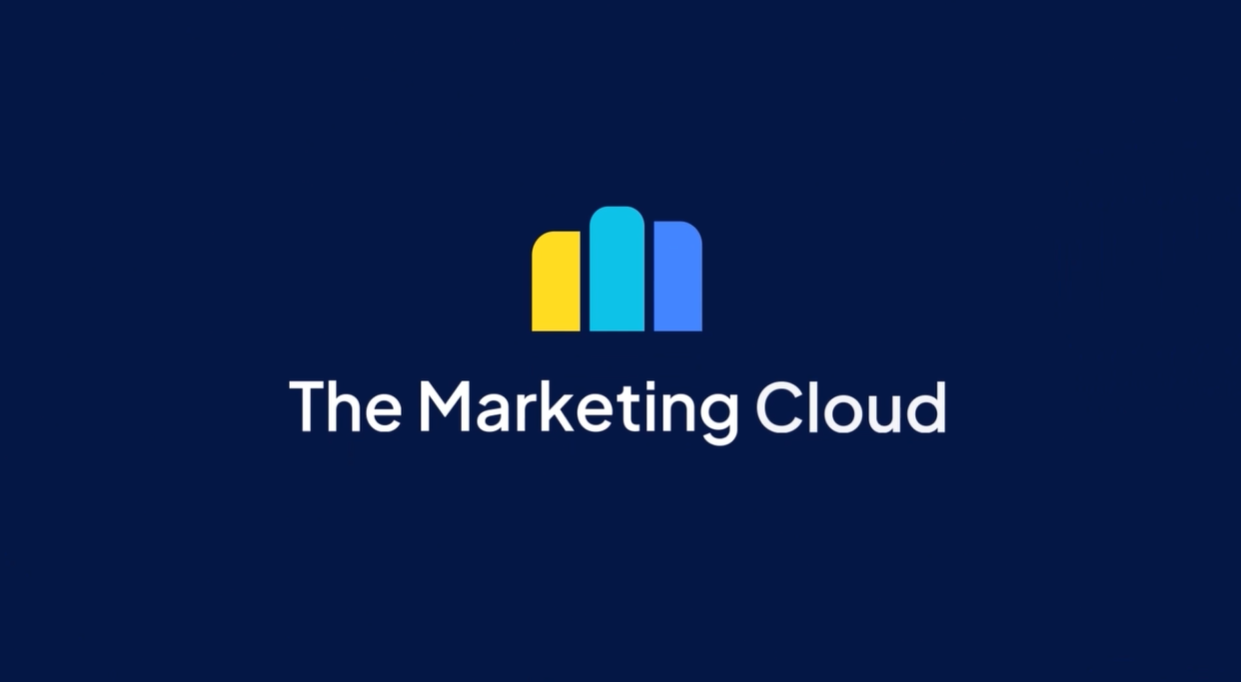
Newsletter
Sign Up
Welcome back to Hitting the Mark, my monthly analysis of developments at the intersection of business, marketing, and politics for modern C-Suite leaders. This month, I look at the metaverse in terms of how it can transform brands – and how it may transform society.
Before we vault to the future, I want to acknowledge the turmoil that the overturning of Roe v. Wade has caused. As predicted in last month’s column, this summer is “chock-full of potentially divisive issues for corporations.” At Stagwell, we moved immediately to provide a travel benefit that ensures all employees maintain access to reproductive healthcare. I worked for Planned Parenthood of New York as their consultant for 10 years in the late ’70s and ’80s when this legal battle was new – and feel strongly about protecting choice.
As you consider how to navigate this issue, our Harvard CAPS/Harris data shows that while most people would have supported continuing Roe, a majority would also have supported rollbacks to the viability standard as proposed by Justice Roberts, and large majorities oppose late-term abortions. The July edition of the Harvard CAPS/Harris Poll – released today – continues to track American sentiment post-Roe. If you’d like to connect for advice on how to navigate this landscape, please reach out.
Turning to the topic of this month’s newsletter, the metaverse. Today’s business leaders are faced with two major discussion tracks around the metaverse: how will it transform my brand? And how will it transform society?
The Metaverse and Brands
On the first: I had the pleasure earlier this June of giving a fierce argument on behalf of the future of the metaverse at the prestigious Oxford Union, alongside technologists, academics, journalists, and brand leaders seeking to determine whether “this house should live in the metaverse.” Spoiler alert: we lost the debate. But I got some interesting insights from the audience – mostly younger, Gen Z consumers. The reasons why we lost prove there’s much for marketers to dig in on as they drum up consumer excitement about the metaverse, map its contours, and start innovating their technologies, products, and services.
Younger consumers are cynical almost to the point of anger about Big Tech and FAANG dominating the metaverse. I heard impassioned speeches from the opposition about the various ailments Web2 platforms have unleashed on the world, from broken freedom of speech to harassment, to the consolidation of power, and more. And that tracks with recent research from National Research Group showing consumers think the Internet has become more commercialized (80%), addictive (79%), and has encouraged people to treat each other more cruelly (69%).
- My take: Big tech beware: if you look at the arc of innovation, tech empires have limited lifespans. Myspace fell to Facebook. YouTube is losing ground to TikTok. Facebook’s social empire based on the sale of user data is shrinking. In the metaverse, I believe Big Tech will certainly be part of the equation, but the hardware, servers, and aspects of the tools needed to build dominant visions of the metaverse and Web3 may push many new worlds and businesses into the market
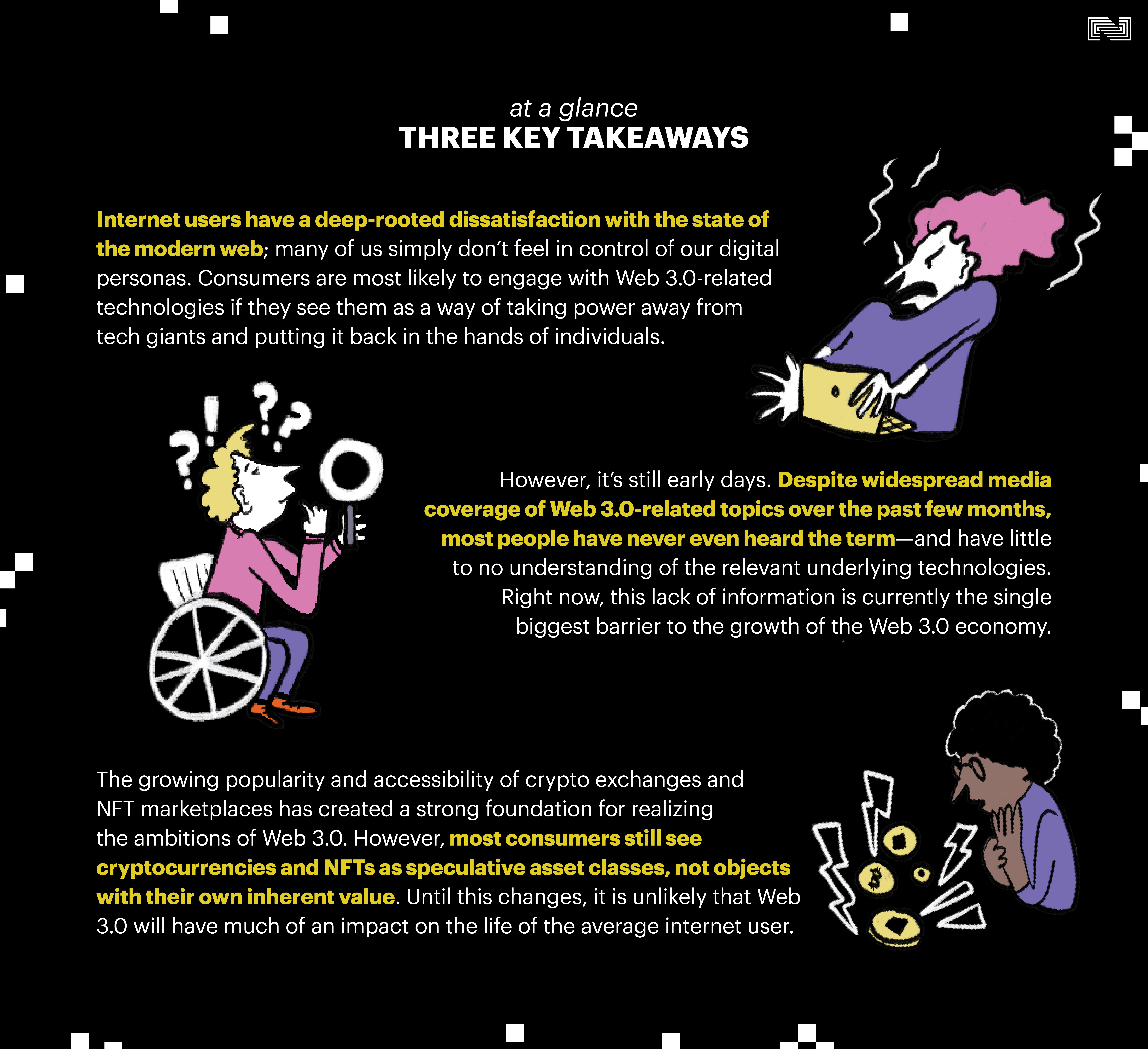
These Oxfordians challenge the idea you can live a fulfilling life in the metaverse, even as they see the potential for it to scale and democratize access to global travel, quality education, and shared experiences. Blame it on the propensity of the young to see apocalypses lurking behind every corner or on the lingering psycho-social effects of the pandemic, but younger consumers are worried metaverse tech will open Pandora’s Box into a social dystopia where consumers live more in virtual reality than real life.
- My Take: What they ignore – and where brands have an opening to bridge this gap – is the sheer volume of time we already spend in digital and virtual realities. A reliance on digital existence is already a norm and could intensify, given more engaging and immersive metaverse worlds. This may actually lead to a more positive state of mental health in comparison to current screen time practices.
Oxford listeners are just as confused about the terminology as brand marketers (but that doesn’t matter). Metaverse? Web3? Blockchain? Younger consumers are just as baffled by the buzzwords as senior brand marketers. But they’re not invested in the halo excitement around this fresh new tech – and unimpressed with many of the early metaverse experiments which don’t model the true potential of Web3.
- My Take: The most helpful definition brands can work with is, the metaverse is not a single application, or program, or virtual reality – it’s, as Wired points out, a multiverse of metaverses. Like streaming services, there are many, constantly competing with other groups, constantly breaking into new content niches. While it may benefit technologists and investors to think of the metaverse in the context of cryptocurrency of NFTs, there is no necessary connection between the multiverse of metaverse and those terms. They are only part of the tech-bro world, along with unrelated ideologies. Your best bet as a brand playing in the metaverse over the next year? Think about it in the context of the experiences it can create, more so than the technology that needs to be built to reach its most perfect vision
The Metaverse and Society
Beyond pure brand applications, the metaverse promises to transform society for the better. There are four immediate Metaverse applications that illustrate the power of this technology – and why we’re bullish on ensuring it comes to life. The below is an excerpt from my speech at the Oxford Union.
Metaverse One: Avatar interviewing can massively increase women’s’ success in the job market.
Should we wait decades for attitudes to change or hope that implicit bias training will someday produce effective and lasting results? No. You are likely aware of the practice of blind auditions to select members of symphony orchestras.
In the past, candidates would perform before a selection committee on stage, where the gender of candidates was obvious. To combat likely gender bias, most American symphonies now conduct auditions with the performer behind a screen — only their music matters. The Guardian reported that the use of screens increases the odds that a woman will advance from preliminary rounds to finals by 50%! The percentage of women in American symphony orchestras has risen from 5% to nearly 30% in the period after screens were adopted.
Imagine if job interviews were gender-neutral. Interviewers would meet with identical avatars distinguished only by their answers to interview questions and the questions that prospective employers ask. The metaverse could create a level playing field in hiring unimaginable in today’s world. Millions of women are waiting for the metaverse to advance their careers.
Metaverse Two: The opportunity afforded by debate can reach thousands more. The Yale University high school tournament ordinarily brings 300 teams to its most heavily attended division of debate. In the Fall of 2020, 900 teams participated – three times as many when costs are reduced to a cell connection and a 4G cellphone, accessible to anyone for a small fraction of the cost of physical tournament attendance. Remarkably, by eliminating the expense of air travel, hotel stays, and local transportation, these efforts have significantly improved access for thousands of students. Are these events as moving, as satisfying, as physical attendance? Perhaps not, depending on how much you loathe the hassle, expense, and friction of travel, a virtual tournament has many advantages.
But, with a multiverse of 3D speakers, who can go to rounds, wander a virtual campus, gather at virtual cafes to discuss the resolution and complain about teammates and judges, the experience can be made both more satisfying and really, really cheap. By making debate more accessible to students everywhere the many lifelong advantages of this activity can reach hundreds of thousands of students who are denied access by the accidents of geography and economic status.
Metaverse Three: The metaverse can produce an explosion of educational opportunity. Zoom was a very taxing first step in distance learning. Let’s be clear: hours on a Zoom lecture can be mind-crippling. This explains the failure of Massive Open Online Classrooms – MOOCS – that enroll many and graduate almost no one because they are primarily cameras in lecture halls.
But the Metaverse is not your father’s Zoom technology. Within a metaverse environment with classmates around a table, with course materials available at a click to all within a classroom, everything can change. No one disputes that an immersive, high-resolution environment is greatly more engaging than Zoom. If a professor wants you to study the Great Pyramids at Giza, you can go there in photoreal environments. You can tour the tombs of Cheops and Tutankhamun in real time. You can examine exhibits at the Louvre without pushing through crowds of tourists. Lab experiments can be performed before your very eyes. It is true that a picture is worth a thousand words – but a lived experience is worth a thousand pictures.
Metaverse Four: Medical miracles. For example, the BBC tells the story of one British woman who recounted her joyous experience of visiting new worlds and environments after being left severely disabled by a traumatic brain injury. These interventions—priced only at the rapidly decreasing cost of a VR headset—have the potential to bring people immense benefits, ranging from stress relief, anxiety treatment, and amelioration of chronic pain.
Furthermore, such technology will dramatically improve surgical training, saving lives and limbs. One study finds that surgical trainees using VR learned a procedure nearly seven times faster than their traditionally trained counterparts; the technology helps to always keep surgeons’ focus on their patients rather than on external displays. Additionally, consulting doctors in virtual reality for minor ailments can help reduce strain on the already-overwhelmed medical industry.
We’ll be inventing and reinventing the metaverse for years, if not decades, to come. To make the metaverse perform for consumers (not just for those of us geeking out about the technology) brands are going to need to keep their ears to the ground with polling, surveys, and data analysis to track where consumers see the metaverse adding value – and where they’re just confused about why brands are serving virtual hot dogs.
Until next time,
Mark Penn
Related
Articles
In the News, Press Releases
Jul 09, 2025
STAGWELL LAUNCHES STAGWELL MEDIA PLATFORM (SMP), A CENTRALIZED TEAM OF GLOBAL MEDIA, TECHNOLOGY AND DATA INVESTMENT EXPERTS

In the News, Investments & Financials, Press Releases
Jul 08, 2025
Stagwell (STGW) Schedules Webcast to Discuss Financial Results for the Three Months Ended June 30, 2025

In the News, Investments & Financials, Press Releases, Talent & Awards
Jul 08, 2025
Stagwell (STGW) Advances Executive Team with Four Key Appointments

Newsletter
Sign Up
Welcome to the second edition of Hitting the Mark – a monthly analysis of developments at the intersection of business, marketing, and politics meant for the modern C-Suite. This month’s topic? Inflation.
Inflation is in many ways the most pernicious of economic problems because it affects so many people at the same time. Inflation is at its highest rate since the early 1980s, and, as I wrote recently in the New York Times, “Many Americans under 60 have relatively little experience with anything but comparatively low fuel costs, negligible interest rates, and stable prices. Virtually overnight these assumptions have been shaken.” Consumers are already changing their behavior, becoming more cautious and pessimistic about the state of the economy. All of those COVID savings are being eaten up through the mystery of runaway higher prices.
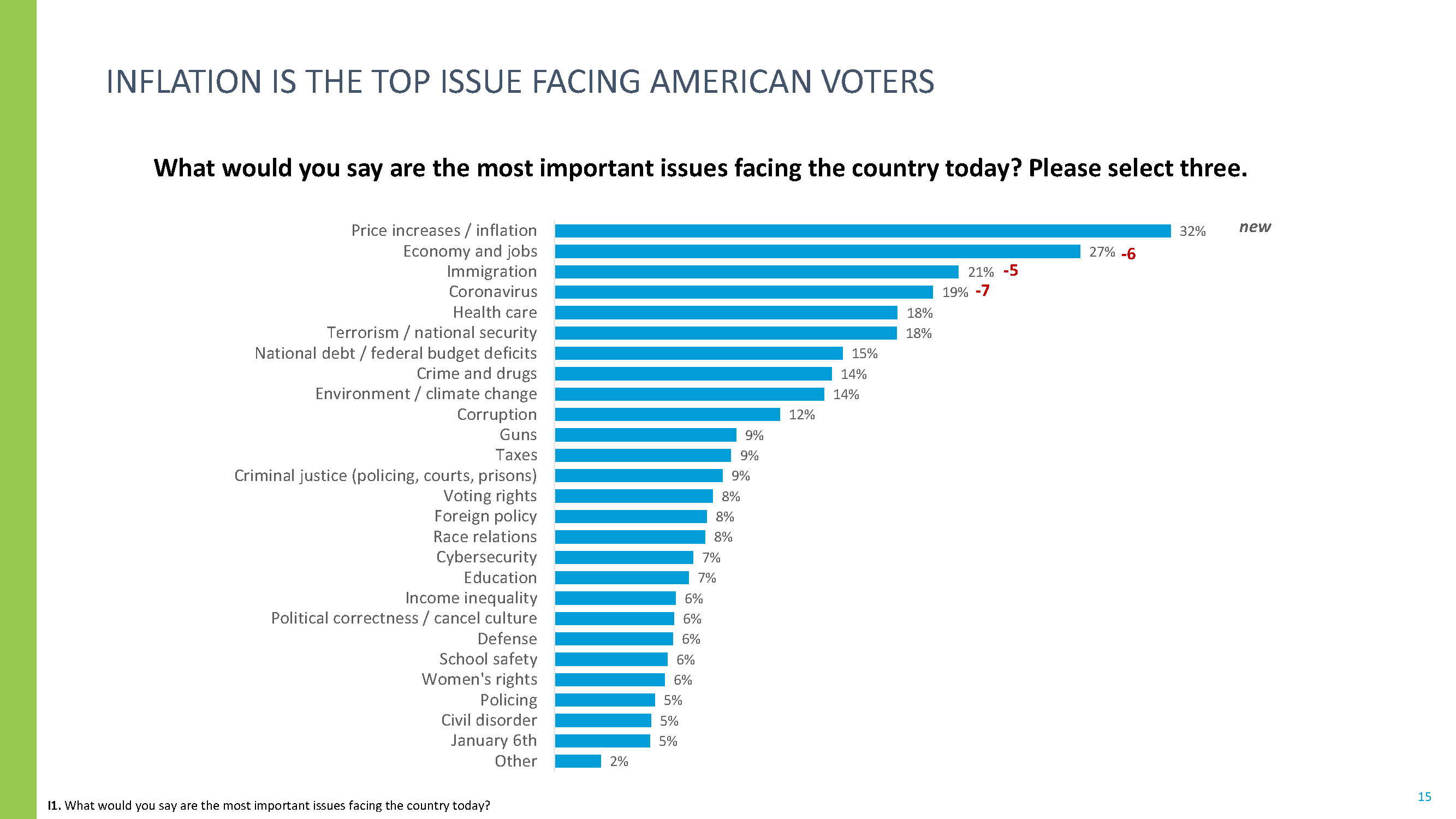
Most marketers have some real choices in how to respond to inflation and the goal is to be on the side of the consumer during these more difficult economic times.
Of course, the easiest solution is simply to raise prices. It’s no longer 10 cents for a pack of gum; one bellwether of higher prices is the cost of treats like chocolate and spearmint. In 1974 a pack of 7 sticks of gum cost 15 cents. That probably does not even cover the sales tax on a package of gum today. Chocolate is a luxury and luxuries have the most elastic pricing, so they generally have the most room to simply pass on cost increases, so don’t expect to pay the same at the Godiva store.
Other companies have tried hard to conceal price increases by simply reducing the quantity. Cereal companies are famous during inflationary times for simply taking an ounce or two out of those cereal boxes. Consumers can easily miss this shrinkage but go too far and expect a backlash.
Perhaps the best way to get on the side of consumers during this time is to offer bigger units at lower prices. This is why Sam’s Club and Costco generally do better during these times, as their business model is all about delivering more value for less.
Inflation is of course great for products that are perceived as keeping pace with inflation. No product is known for holding its value more than gold – expect the airwaves to be filled with ads that sell gold as the one true hedge against rising prices.
Fast food prices and their consumers are super sensitive to inflation. As the McDonald’s dollar menu inches up from $1, to $2, to $2, its competitors have done a great job advertising $5 fill-up boxes that are brimming with food. These “inflation busters” become the perfect partners to penny-pinched consumers. While prices for organic groceries soar, families know they can rely on these restaurants to remain affordable.
What does this mean for marketing?
Growth slows during inflationary times, so marketing will also be more about fighting for market share than selling new products to first-time consumers. This means that effective competitive marketing will be a lot more useful for brands. Especially when consumers are motivated by cost-saving, nothing can be quite as powerful as reminding them of the superior value of your business versus competitors.
It’s important to remember that value is not always the same as cost. I once ran advertising on behalf of Microsoft against Linux. Linux was difficult to compete against because the company was giving away some of its software for free. We created the concept of the “total cost of ownership” and showed that the free offering, over time, would be more costly than paying Microsoft. This campaign labeled “Get the Facts” was a huge success.
Focus is important during inflationary times. The consumer is once again king, and behaving somewhat like a taxpayer, skeptical of companies who are focused on giving their money away for causes because they feel like they are being called upon to finance these programs out of pocket when they buy goods and services. Companies with a heavy focus on social programs should evaluate whether they will now be seen as out of step with the needs of consumers. While helping soup kitchens might still be a popular idea during inflationary times, funding the opera might raise eyebrows, and throwing a huge fashion show might alienate consumers at this time.
Now is the time to stop simply watching inflation worsen and pick the right strategy for your company, whether it is reducing package sizes, creating affordable bundles, raising costs, or digging into competitive advertising to fight for market share. As for me? I have to go load some gold bars into my car…
Up next in our Hitting the Mark column? The pandemic, inflation, the Russia-Ukraine conflict, political crises – all these issues raise the importance (and trickiness) of “brand leadership” in our modern era. As we noted in Stagwell’s 2021 research on brand reputation, those perceived as delivering solutions to the pandemic received a major reputational boost over the past few years. Today, a majority of voters are not confident in either the Biden administration (55%) or the Federal Reserve’s (56%) ability to fight inflation. Brands won’t deliver the silver bullet to America’s inflation woes but adapting strategy to give consumers a lifeline amid economic stress can go a long way towards building reputational capital.
Stagwell’s 2022 Reputation Quotient, our annual ranking of the 100 most visible companies in America, is set to release in late May. I look forward to sharing an updated picture of the state of corporate reputation and brand leadership then.
Mark Penn
Related
Articles
In the News, Press Releases
Jul 09, 2025
STAGWELL LAUNCHES STAGWELL MEDIA PLATFORM (SMP), A CENTRALIZED TEAM OF GLOBAL MEDIA, TECHNOLOGY AND DATA INVESTMENT EXPERTS

In the News, Investments & Financials, Press Releases
Jul 08, 2025
Stagwell (STGW) Schedules Webcast to Discuss Financial Results for the Three Months Ended June 30, 2025

In the News, Investments & Financials, Press Releases, Talent & Awards
Jul 08, 2025
Stagwell (STGW) Advances Executive Team with Four Key Appointments

Newsletter
Sign Up
Welcome to Hitting the Mark – a critical analysis of developments at the intersection of business, marketing, and politics meant for the modern C-Suite. For our inaugural edition, I tackle the issue keeping leaders awake at night: Russia’s war against Ukraine. Brand leaders: did you ever anticipate you’d be drafted into a war? Well, you have. And here are some thoughts on what to do.
Over two months into Russia’s brazen assault on Ukraine, brands are the newest foot soldiers in the economic warfare the U.S. is waging to isolate Putin and his regime from the rest of the world. The United States has decided it is too dangerous to confront Putin directly, instead electing to levy crushing economic sanctions on the country and encourage U.S. business leaders to do the same. Should U.S. corporations participate in this economic warfare against the Russian people? So far, the answer is a clear yes. Typically, involvement in political issues splits a company’s consumers; in contrast, this move appears to be bringing consumers together.
Unprecedented Consensus on Brand Withdrawal
Per a recent survey by HarrisX into voters’ perceptions on the ongoing Ukraine conflict, about 80% of voters believe all American companies should stop doing business with and in Russia. That holds across two key segments we polled for: tech companies and fast-food companies. Further, 90% of American voters agree that Putin has committed war crimes for his role in the invasion of Ukraine.
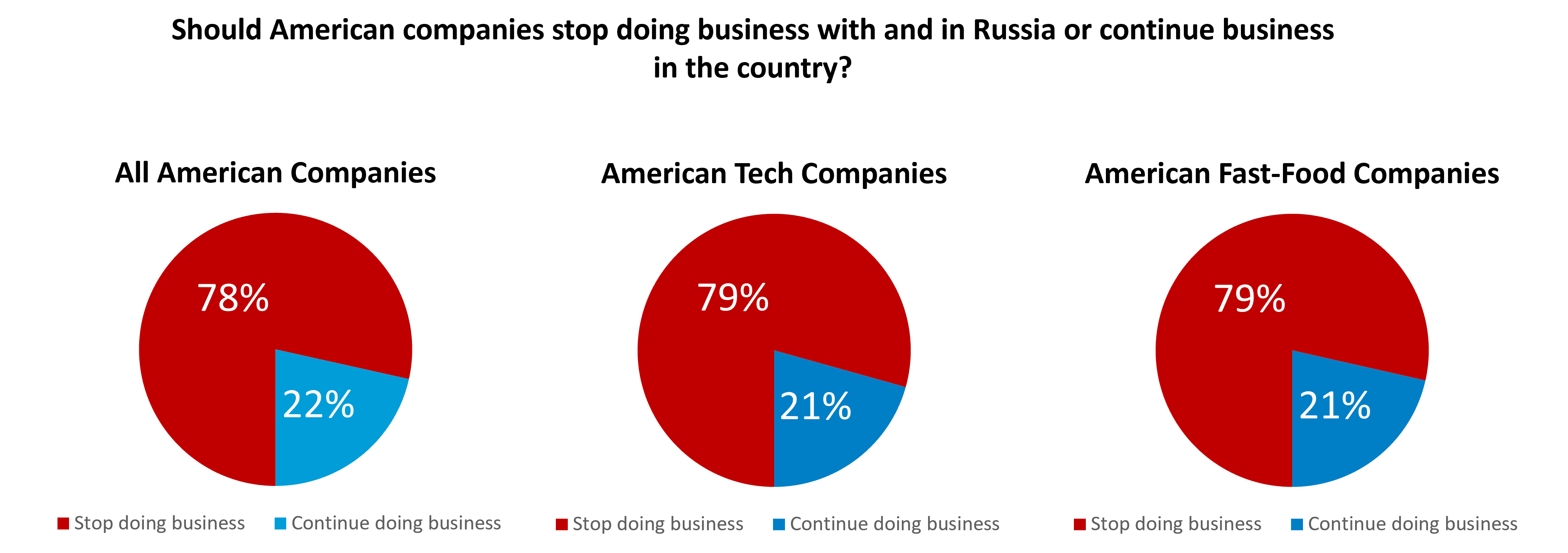
Of course, this decision is easy for companies who have little or no operations in Russia. It is more difficult for those companies that have made a major investment in the country. They may have thousands of employees, stores, and other investments. What will happen to those assets? Will they have an opportunity to re-open operations if peace is achieved? These are difficult questions given the larger ramifications those decisions have.
Given the illegal and immoral actions of Putin’s unrestricted shelling of innocent civilians, an overwhelming number of well-known brands have either pulled out of Russia or suspended operations there. Morality surely swayed many; Anonymous, the hacker group, also threatened cyber-attacks against companies that did not withdraw. In the U.S., the sentiment is so strongly in favor of Ukraine and against Russia that any company remaining in the region is likely to draw significant consumer and media disapproval. Watch Nestle closely: the brand took a middle ground, announcing it would continue to sell baby food and products while pulling out of more indulgent lines like KitKat, and are donating any profits to the Ukraine relief cause.
Tech in Hot Water
Tech companies are as likely to be banned by Russia as they are to ban operations in Russia. Tech companies have generally focused on US internal political battles and yet carried the accounts of the Ayatollah Khomeini of Iran on an unfiltered basis. RT, a U.S.-based news operation that really was a Russia propaganda front, operated online here for years without interruption. By continuing to operate, tech companies argue they are serving as a communications channel into Russia. At the same time, they could be vehicles for the spread of Russia propaganda. As of now:
- Facebook is banned in Russia while Goggle continues to operate there in limited fashion.
- Google News has been banned though it appears search is still operating. Google advertising has been shut down voluntarily.
- YouTube is operating but they have prevented the Russian military from posting videos of “liberation” on the site and so is under threat of being banned by Russia.
Business software companies like Salesforce, Slack, Dell, Microsoft and IBM stopped selling to new customers while supporting old ones for now. Many had policies of not doing business with the Russian military in any event. Perhaps the single most significant help from tech companies for Ukraine is the deployment of Starlink satellites by Elon Musk. These provide an uncuttable lifeline to the Ukrainian people and government to stay connected and communicate to the outside world.
Et Tu, Vodka?
Then there are the companies – especially vodka companies – that have for years traded on the idea they were Russian in origin, now communicating with consumers that they were really American or European after all. This is some careful marketing legerdemain.
Companies will not be able to right every wrong, and as a matter of policy we have encouraged companies to operate in areas like China as part of showing other cultures how democracy, and economic freedom work together. There is now far less belief that by working with rogue regimes, we can change them; 3 In 5 Americans in the latest HarrisX poll now reject that strategy and believe we are better off disengaging.
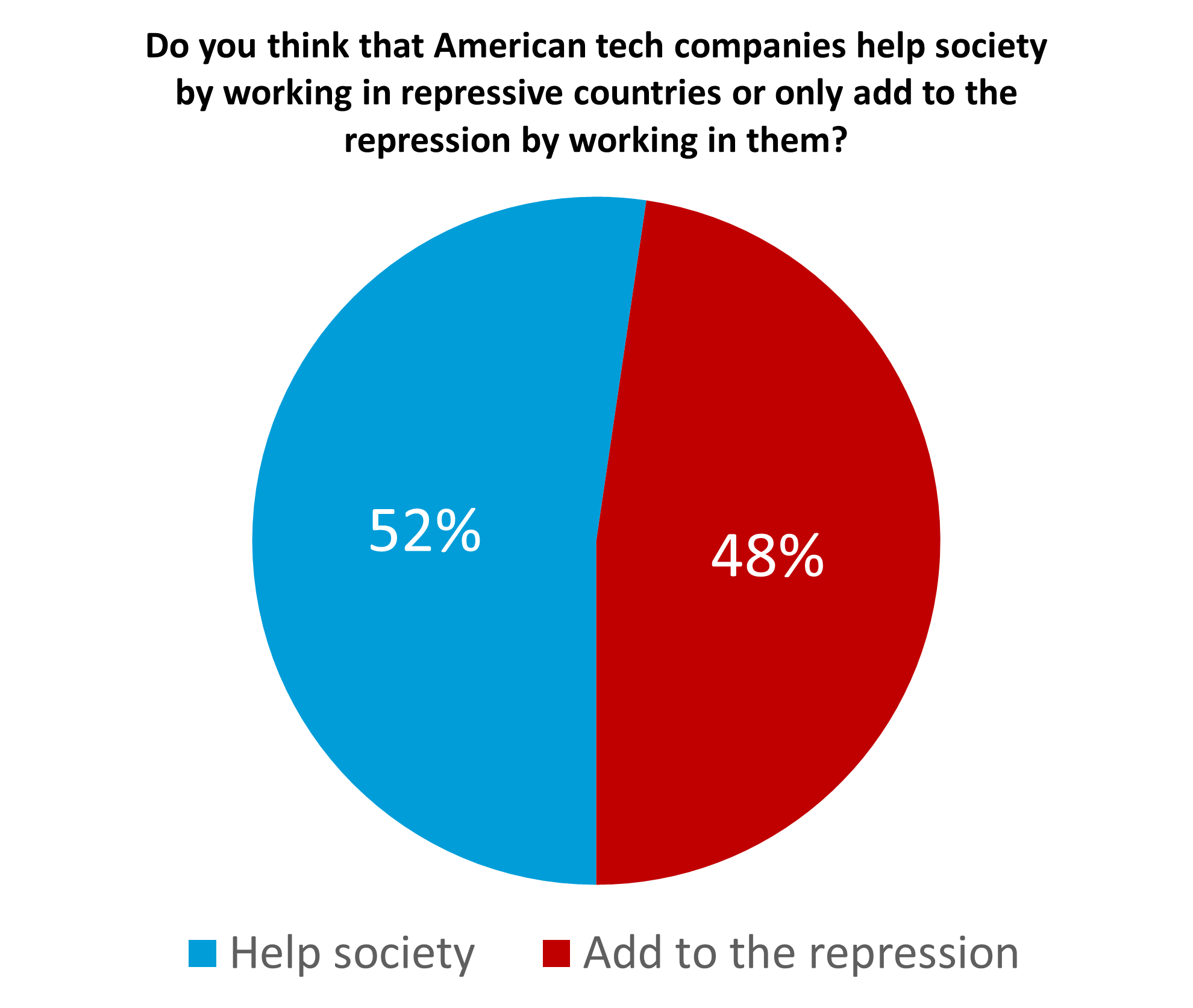
When President Bill Clinton addressed the conflict in Kosovo, a non-NATO country, in a speech that I helped work on, he argued stopping the atrocities against civilians there was an imperative because 1) it was morally right and 2) it was within our capacity to fix. The situation in Russia is similar as there is no real moral issue or debate – this is clearly naked and unjustified aggression on a scale we have not seen since World War II. American companies should feel confident that pulling out of their Russian operations will by and large not hurt their American operations. This is both the right thing to do and what is within our capacity as business leaders to do.
Have thoughts about the Russia-Ukraine war, brands’ responsibilities in it, or corporate purpose? Email me at mark.penn@stagwellglobal.com.
Related
Articles
In the News, Press Releases
Jul 09, 2025
STAGWELL LAUNCHES STAGWELL MEDIA PLATFORM (SMP), A CENTRALIZED TEAM OF GLOBAL MEDIA, TECHNOLOGY AND DATA INVESTMENT EXPERTS

In the News, Investments & Financials, Press Releases
Jul 08, 2025
Stagwell (STGW) Schedules Webcast to Discuss Financial Results for the Three Months Ended June 30, 2025

In the News, Investments & Financials, Press Releases, Talent & Awards
Jul 08, 2025
Stagwell (STGW) Advances Executive Team with Four Key Appointments


